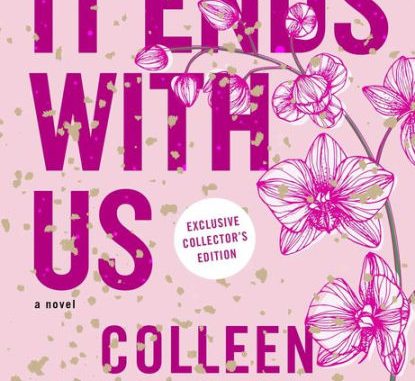
By Michela Arlia
Colleen Hoover’s novel “It Ends With Us” claims the phrase “every person with a heartbeat should read this book” on its cover. Well, I have a heartbeat, but I must admit that after reading it, I lost some respect for the young adult genre and quite frankly, the author.
Originally released in 2016, the novel regained much popularity in the summer of 2021 on social media. A sequel to its story was released this past fall.
The story focuses on Lily, a 23-year-old with an entrepreneurial dream, and Ryle, an up-and-coming neurosurgeon in Boston. In an unexpected meeting one night, the pair grapple with their haunted pasts as they begin a flirtatious relationship that only lasts the course of the night, as a blatant interruption leads them to not see each other for a while.
Fast forward six months and Lily now owns a flower shop, where she runs into Ryle once again. This time, they decide to take their relationship to the next level. They then marry and have a rocky, questionable start to their relationship.
Both characters had traumatic childhoods. Lily grew up a witness and then victim to her father’s abuse towards her and her mother, and Ryle constantly re-lives his nightmare of shooting and killing his brother when he was six years old with a gun that should have never been in his hands.
Early in Lily and Ryle’s relationship, Ryle begins to abuse Lily physically. A repetition of behaviors for her, Lily is stunned yet does not see the signs of her abuser. This is the first red flag.
Lily continues to stay with Ryle as the abusive episodes heighten more and more.
In the end, Lily divorces Ryle only after having a child with him.
To begin, the content warning in this book is very misleading in that it does not contain one at all. The explicitness in descriptions of abuse and other acts performed within the book are not known to the reader ahead of time. This became very unsettling to think that young teenagers who may pick this book up would be exposed to levels of maturity they are not ready for. On the flip side, victims of abuse may begin to read this book, and while getting through the story, are brought back to dark unwanted times.
The writing, however, was really well done. Hoover was very descriptive, painting a picture in your mind of what exactly was happening in the storyline. Her use of various descriptive words made it very easy to depict everything, including the emotions and conflicts within the characters.
This story was told through Lily’s point of view the entire time, but maybe it shouldn’t have been. This only further glorified the abuser. Perhaps if we heard things from Ryle’s point of view, we would know exactly why we hate him for what he did to Lily.
Even though Hoover does a great job detailing experiences, she feeds into the stigma of abuse and accepting or loving your abuser. This sends a completely disheartening message, masking it to seem alright to give your abuser one last try, knowing you will be hurt again. There was not enough action by characters outside of the pair’s relationship that warned Lily of the maltreatment. That spoke volumes as a reader, for there was no one truly on Lily’s side to bring her to the light from the very first time she saw signs of an abusive partner.
This story only glorified male dominance in an abusive relationship. While it can be argued that this was the point of Hoover’s writing, to see firsthand what abuse looks like, it still sends a mixed message by giving this situation a platform to stand on at all. There was too much explanation and not enough awareness.
At the book’s end, there is a note on who to call if you or someone you know experienced abuse. That just feels like a formality once you get through the entirety of the story.
